Elder Abuse in the UK: A Comprehensive Analysis of the Problem
VerifiedAdded on 2022/02/28
|31
|9164
|21
Report
AI Summary
This report provides a comprehensive overview of elder abuse in the UK, addressing its various forms, including physical, emotional, financial, and neglect. It delves into the social and historical context of elder abuse, exploring the causes and potential preventive interventions. The methodology section outlines the research approach, design, and data collection methods employed in the study. The results and discussion chapter presents the findings, analyzing the factors contributing to elder abuse and the challenges faced in addressing this issue. The report also includes a literature review, research ethics, and limitations, culminating in conclusions and recommendations for future actions to combat elder abuse. The study emphasizes the increasing concern regarding the mistreatment of the elderly and the importance of developing informed policies and programs to safeguard them.
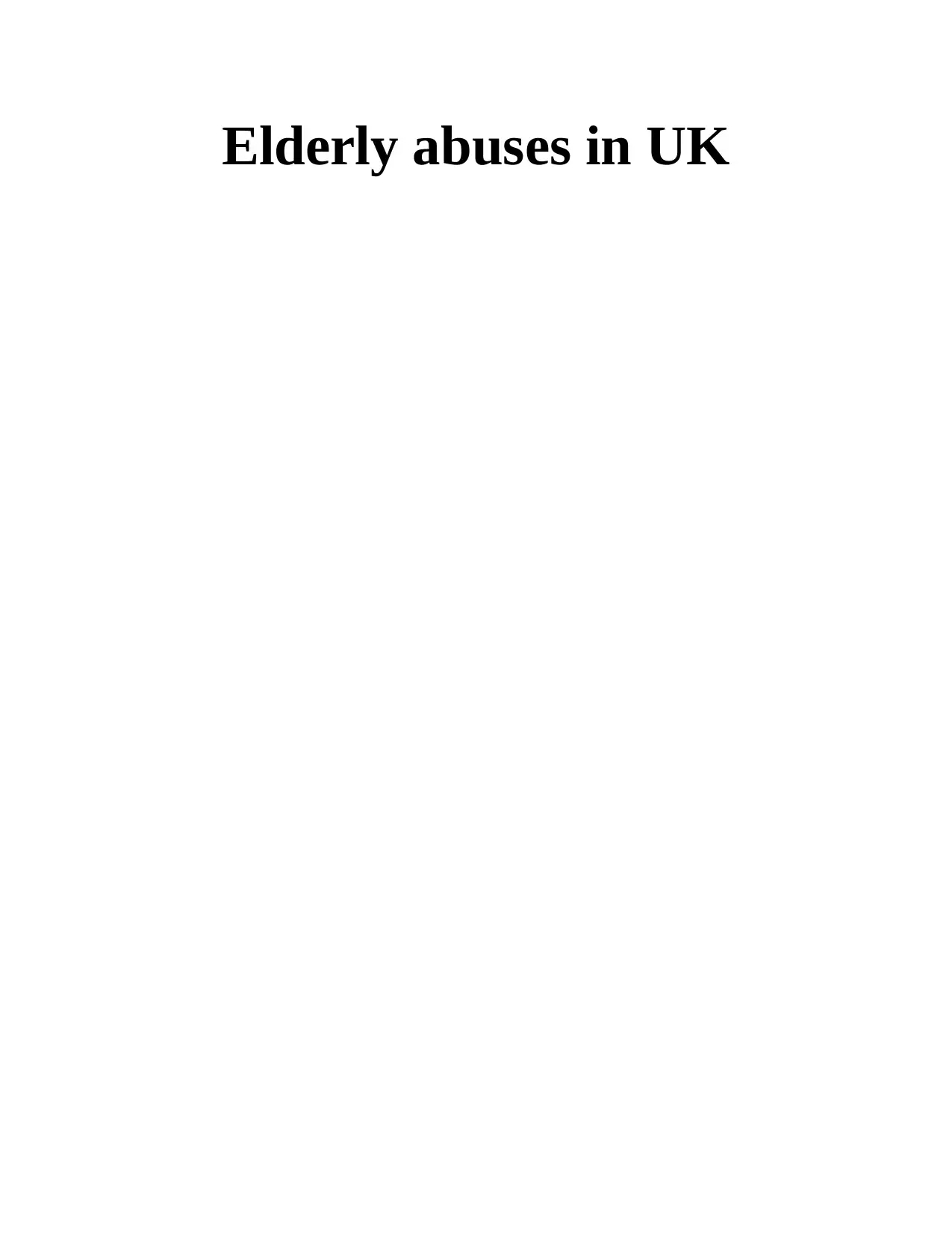
Elderly abuses in UK
Paraphrase This Document
Need a fresh take? Get an instant paraphrase of this document with our AI Paraphraser
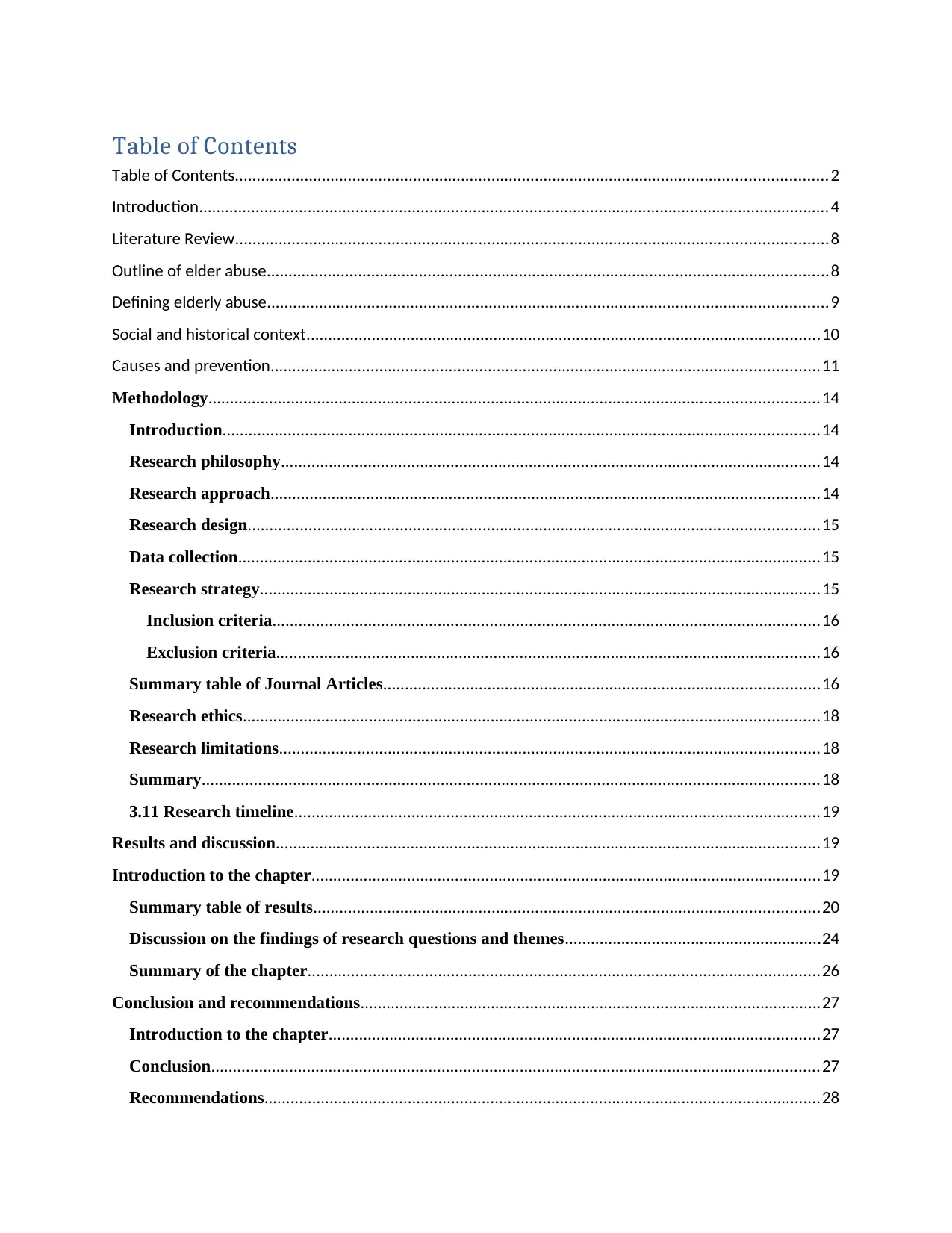
Table of Contents
Table of Contents........................................................................................................................................2
Introduction.................................................................................................................................................4
Literature Review........................................................................................................................................8
Outline of elder abuse.................................................................................................................................8
Defining elderly abuse.................................................................................................................................9
Social and historical context......................................................................................................................10
Causes and prevention..............................................................................................................................11
Methodology............................................................................................................................................14
Introduction.........................................................................................................................................14
Research philosophy............................................................................................................................14
Research approach..............................................................................................................................14
Research design...................................................................................................................................15
Data collection......................................................................................................................................15
Research strategy.................................................................................................................................15
Inclusion criteria..............................................................................................................................16
Exclusion criteria.............................................................................................................................16
Summary table of Journal Articles....................................................................................................16
Research ethics....................................................................................................................................18
Research limitations............................................................................................................................18
Summary..............................................................................................................................................18
3.11 Research timeline.........................................................................................................................19
Results and discussion.............................................................................................................................19
Introduction to the chapter.....................................................................................................................19
Summary table of results....................................................................................................................20
Discussion on the findings of research questions and themes...........................................................24
Summary of the chapter......................................................................................................................26
Conclusion and recommendations..........................................................................................................27
Introduction to the chapter.................................................................................................................27
Conclusion............................................................................................................................................27
Recommendations................................................................................................................................28
Table of Contents........................................................................................................................................2
Introduction.................................................................................................................................................4
Literature Review........................................................................................................................................8
Outline of elder abuse.................................................................................................................................8
Defining elderly abuse.................................................................................................................................9
Social and historical context......................................................................................................................10
Causes and prevention..............................................................................................................................11
Methodology............................................................................................................................................14
Introduction.........................................................................................................................................14
Research philosophy............................................................................................................................14
Research approach..............................................................................................................................14
Research design...................................................................................................................................15
Data collection......................................................................................................................................15
Research strategy.................................................................................................................................15
Inclusion criteria..............................................................................................................................16
Exclusion criteria.............................................................................................................................16
Summary table of Journal Articles....................................................................................................16
Research ethics....................................................................................................................................18
Research limitations............................................................................................................................18
Summary..............................................................................................................................................18
3.11 Research timeline.........................................................................................................................19
Results and discussion.............................................................................................................................19
Introduction to the chapter.....................................................................................................................19
Summary table of results....................................................................................................................20
Discussion on the findings of research questions and themes...........................................................24
Summary of the chapter......................................................................................................................26
Conclusion and recommendations..........................................................................................................27
Introduction to the chapter.................................................................................................................27
Conclusion............................................................................................................................................27
Recommendations................................................................................................................................28
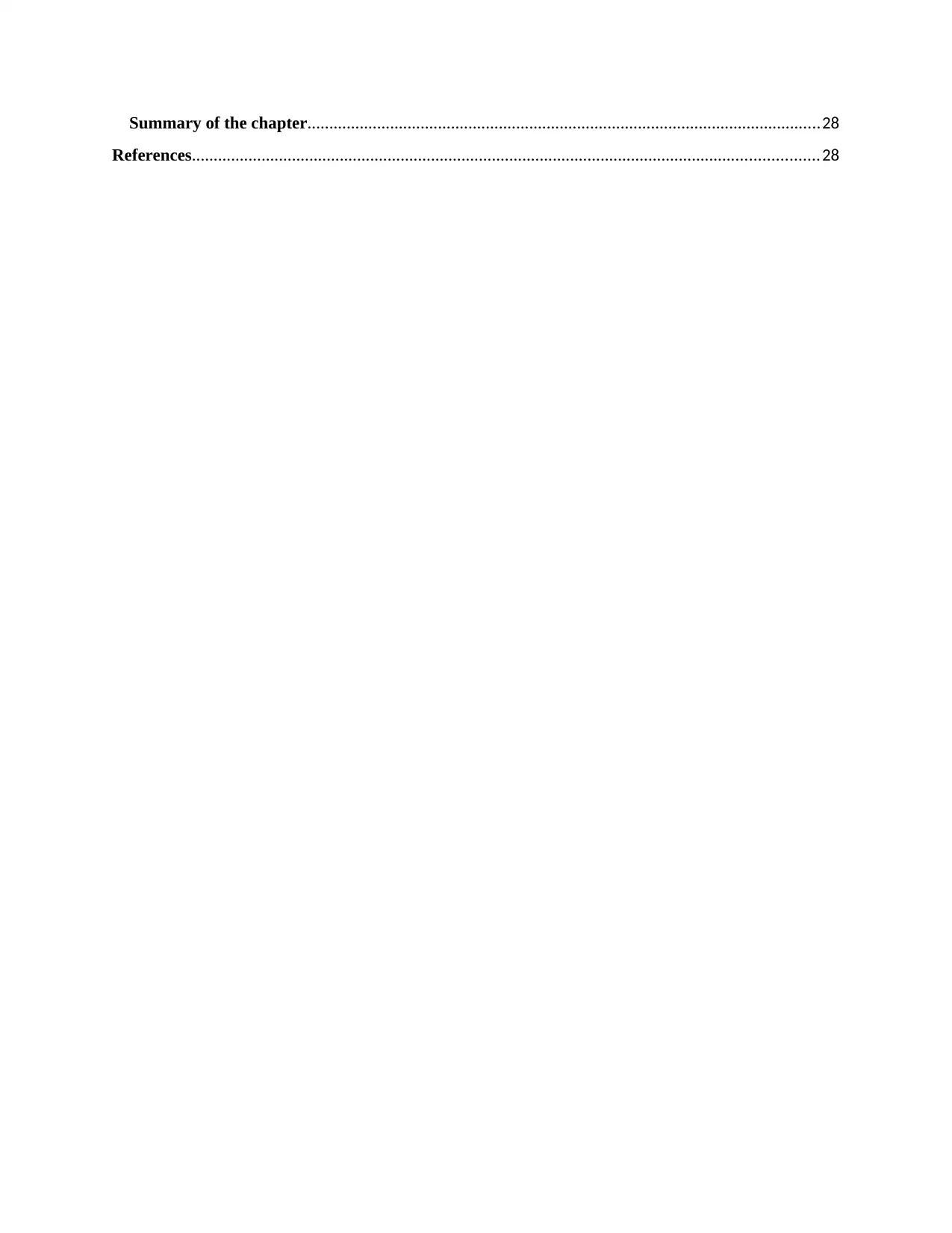
Summary of the chapter......................................................................................................................28
References................................................................................................................................................28
References................................................................................................................................................28
⊘ This is a preview!⊘
Do you want full access?
Subscribe today to unlock all pages.

Trusted by 1+ million students worldwide
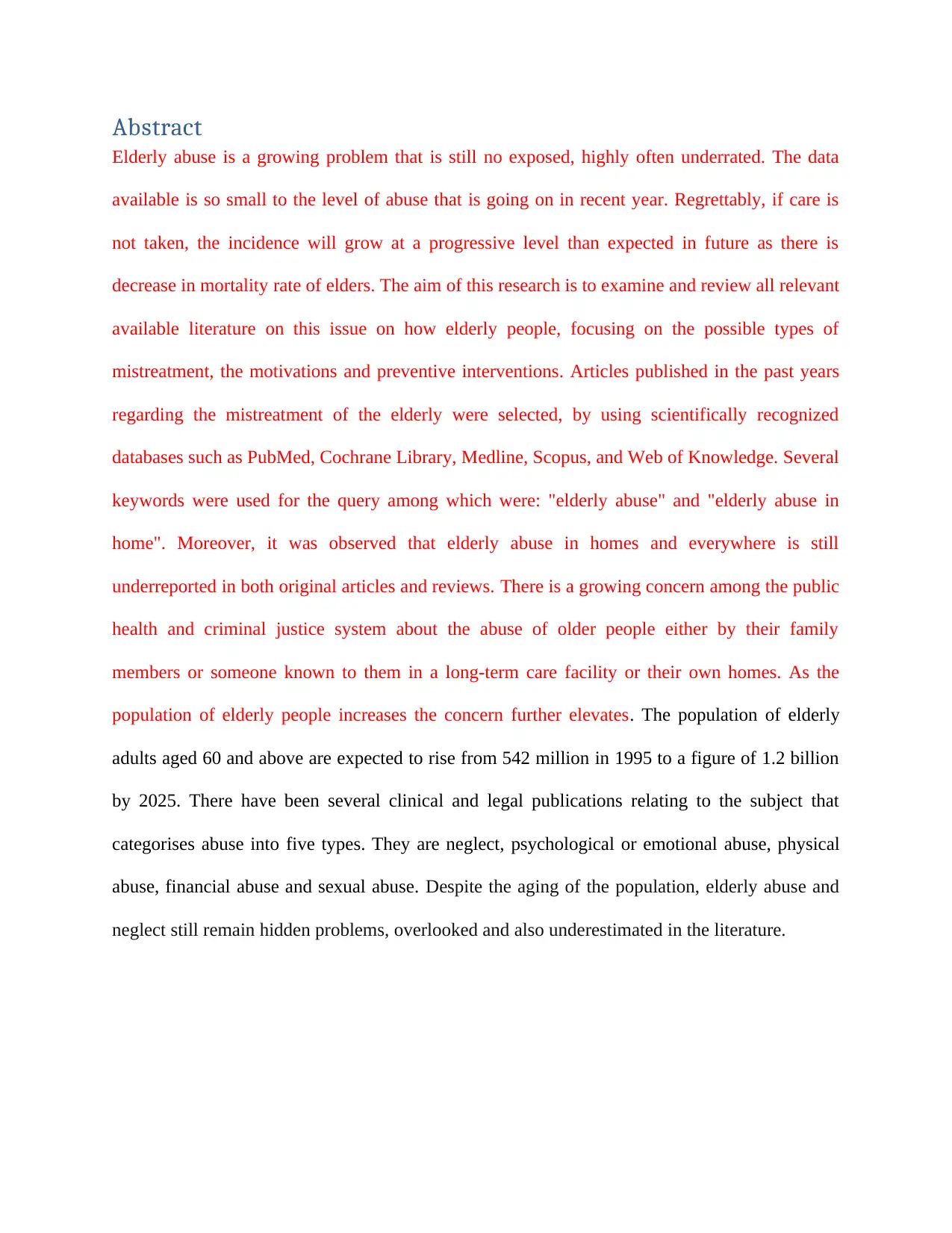
Abstract
Elderly abuse is a growing problem that is still no exposed, highly often underrated. The data
available is so small to the level of abuse that is going on in recent year. Regrettably, if care is
not taken, the incidence will grow at a progressive level than expected in future as there is
decrease in mortality rate of elders. The aim of this research is to examine and review all relevant
available literature on this issue on how elderly people, focusing on the possible types of
mistreatment, the motivations and preventive interventions. Articles published in the past years
regarding the mistreatment of the elderly were selected, by using scientifically recognized
databases such as PubMed, Cochrane Library, Medline, Scopus, and Web of Knowledge. Several
keywords were used for the query among which were: "elderly abuse" and "elderly abuse in
home". Moreover, it was observed that elderly abuse in homes and everywhere is still
underreported in both original articles and reviews. There is a growing concern among the public
health and criminal justice system about the abuse of older people either by their family
members or someone known to them in a long-term care facility or their own homes. As the
population of elderly people increases the concern further elevates. The population of elderly
adults aged 60 and above are expected to rise from 542 million in 1995 to a figure of 1.2 billion
by 2025. There have been several clinical and legal publications relating to the subject that
categorises abuse into five types. They are neglect, psychological or emotional abuse, physical
abuse, financial abuse and sexual abuse. Despite the aging of the population, elderly abuse and
neglect still remain hidden problems, overlooked and also underestimated in the literature.
Elderly abuse is a growing problem that is still no exposed, highly often underrated. The data
available is so small to the level of abuse that is going on in recent year. Regrettably, if care is
not taken, the incidence will grow at a progressive level than expected in future as there is
decrease in mortality rate of elders. The aim of this research is to examine and review all relevant
available literature on this issue on how elderly people, focusing on the possible types of
mistreatment, the motivations and preventive interventions. Articles published in the past years
regarding the mistreatment of the elderly were selected, by using scientifically recognized
databases such as PubMed, Cochrane Library, Medline, Scopus, and Web of Knowledge. Several
keywords were used for the query among which were: "elderly abuse" and "elderly abuse in
home". Moreover, it was observed that elderly abuse in homes and everywhere is still
underreported in both original articles and reviews. There is a growing concern among the public
health and criminal justice system about the abuse of older people either by their family
members or someone known to them in a long-term care facility or their own homes. As the
population of elderly people increases the concern further elevates. The population of elderly
adults aged 60 and above are expected to rise from 542 million in 1995 to a figure of 1.2 billion
by 2025. There have been several clinical and legal publications relating to the subject that
categorises abuse into five types. They are neglect, psychological or emotional abuse, physical
abuse, financial abuse and sexual abuse. Despite the aging of the population, elderly abuse and
neglect still remain hidden problems, overlooked and also underestimated in the literature.
Paraphrase This Document
Need a fresh take? Get an instant paraphrase of this document with our AI Paraphraser
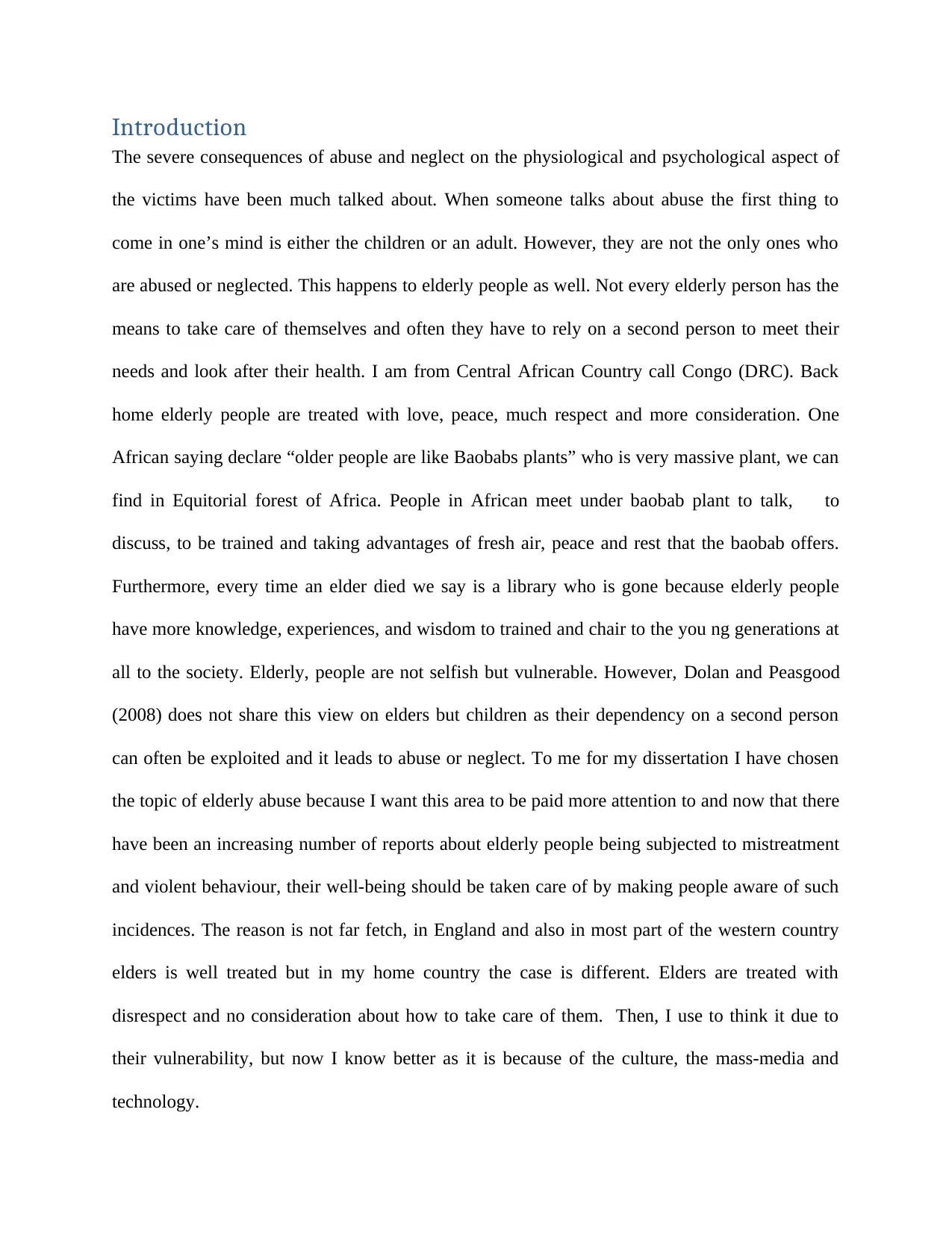
Introduction
The severe consequences of abuse and neglect on the physiological and psychological aspect of
the victims have been much talked about. When someone talks about abuse the first thing to
come in one’s mind is either the children or an adult. However, they are not the only ones who
are abused or neglected. This happens to elderly people as well. Not every elderly person has the
means to take care of themselves and often they have to rely on a second person to meet their
needs and look after their health. I am from Central African Country call Congo (DRC). Back
home elderly people are treated with love, peace, much respect and more consideration. One
African saying declare “older people are like Baobabs plants” who is very massive plant, we can
find in Equitorial forest of Africa. People in African meet under baobab plant to talk, to
discuss, to be trained and taking advantages of fresh air, peace and rest that the baobab offers.
Furthermore, every time an elder died we say is a library who is gone because elderly people
have more knowledge, experiences, and wisdom to trained and chair to the you ng generations at
all to the society. Elderly, people are not selfish but vulnerable. However, Dolan and Peasgood
(2008) does not share this view on elders but children as their dependency on a second person
can often be exploited and it leads to abuse or neglect. To me for my dissertation I have chosen
the topic of elderly abuse because I want this area to be paid more attention to and now that there
have been an increasing number of reports about elderly people being subjected to mistreatment
and violent behaviour, their well-being should be taken care of by making people aware of such
incidences. The reason is not far fetch, in England and also in most part of the western country
elders is well treated but in my home country the case is different. Elders are treated with
disrespect and no consideration about how to take care of them. Then, I use to think it due to
their vulnerability, but now I know better as it is because of the culture, the mass-media and
technology.
The severe consequences of abuse and neglect on the physiological and psychological aspect of
the victims have been much talked about. When someone talks about abuse the first thing to
come in one’s mind is either the children or an adult. However, they are not the only ones who
are abused or neglected. This happens to elderly people as well. Not every elderly person has the
means to take care of themselves and often they have to rely on a second person to meet their
needs and look after their health. I am from Central African Country call Congo (DRC). Back
home elderly people are treated with love, peace, much respect and more consideration. One
African saying declare “older people are like Baobabs plants” who is very massive plant, we can
find in Equitorial forest of Africa. People in African meet under baobab plant to talk, to
discuss, to be trained and taking advantages of fresh air, peace and rest that the baobab offers.
Furthermore, every time an elder died we say is a library who is gone because elderly people
have more knowledge, experiences, and wisdom to trained and chair to the you ng generations at
all to the society. Elderly, people are not selfish but vulnerable. However, Dolan and Peasgood
(2008) does not share this view on elders but children as their dependency on a second person
can often be exploited and it leads to abuse or neglect. To me for my dissertation I have chosen
the topic of elderly abuse because I want this area to be paid more attention to and now that there
have been an increasing number of reports about elderly people being subjected to mistreatment
and violent behaviour, their well-being should be taken care of by making people aware of such
incidences. The reason is not far fetch, in England and also in most part of the western country
elders is well treated but in my home country the case is different. Elders are treated with
disrespect and no consideration about how to take care of them. Then, I use to think it due to
their vulnerability, but now I know better as it is because of the culture, the mass-media and
technology.
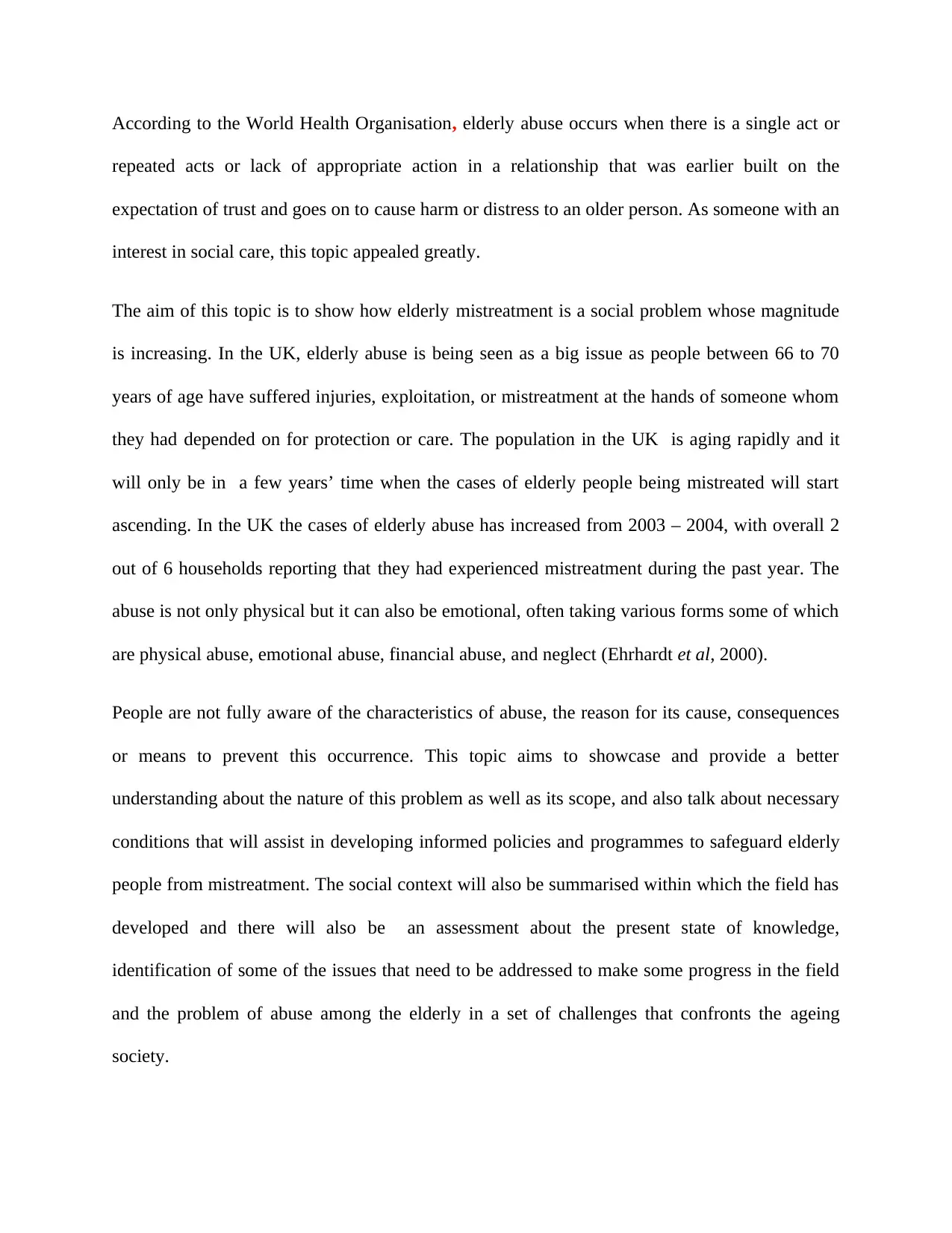
According to the World Health Organisation, elderly abuse occurs when there is a single act or
repeated acts or lack of appropriate action in a relationship that was earlier built on the
expectation of trust and goes on to cause harm or distress to an older person. As someone with an
interest in social care, this topic appealed greatly.
The aim of this topic is to show how elderly mistreatment is a social problem whose magnitude
is increasing. In the UK, elderly abuse is being seen as a big issue as people between 66 to 70
years of age have suffered injuries, exploitation, or mistreatment at the hands of someone whom
they had depended on for protection or care. The population in the UK is aging rapidly and it
will only be in a few years’ time when the cases of elderly people being mistreated will start
ascending. In the UK the cases of elderly abuse has increased from 2003 – 2004, with overall 2
out of 6 households reporting that they had experienced mistreatment during the past year. The
abuse is not only physical but it can also be emotional, often taking various forms some of which
are physical abuse, emotional abuse, financial abuse, and neglect (Ehrhardt et al, 2000).
People are not fully aware of the characteristics of abuse, the reason for its cause, consequences
or means to prevent this occurrence. This topic aims to showcase and provide a better
understanding about the nature of this problem as well as its scope, and also talk about necessary
conditions that will assist in developing informed policies and programmes to safeguard elderly
people from mistreatment. The social context will also be summarised within which the field has
developed and there will also be an assessment about the present state of knowledge,
identification of some of the issues that need to be addressed to make some progress in the field
and the problem of abuse among the elderly in a set of challenges that confronts the ageing
society.
repeated acts or lack of appropriate action in a relationship that was earlier built on the
expectation of trust and goes on to cause harm or distress to an older person. As someone with an
interest in social care, this topic appealed greatly.
The aim of this topic is to show how elderly mistreatment is a social problem whose magnitude
is increasing. In the UK, elderly abuse is being seen as a big issue as people between 66 to 70
years of age have suffered injuries, exploitation, or mistreatment at the hands of someone whom
they had depended on for protection or care. The population in the UK is aging rapidly and it
will only be in a few years’ time when the cases of elderly people being mistreated will start
ascending. In the UK the cases of elderly abuse has increased from 2003 – 2004, with overall 2
out of 6 households reporting that they had experienced mistreatment during the past year. The
abuse is not only physical but it can also be emotional, often taking various forms some of which
are physical abuse, emotional abuse, financial abuse, and neglect (Ehrhardt et al, 2000).
People are not fully aware of the characteristics of abuse, the reason for its cause, consequences
or means to prevent this occurrence. This topic aims to showcase and provide a better
understanding about the nature of this problem as well as its scope, and also talk about necessary
conditions that will assist in developing informed policies and programmes to safeguard elderly
people from mistreatment. The social context will also be summarised within which the field has
developed and there will also be an assessment about the present state of knowledge,
identification of some of the issues that need to be addressed to make some progress in the field
and the problem of abuse among the elderly in a set of challenges that confronts the ageing
society.
⊘ This is a preview!⊘
Do you want full access?
Subscribe today to unlock all pages.

Trusted by 1+ million students worldwide
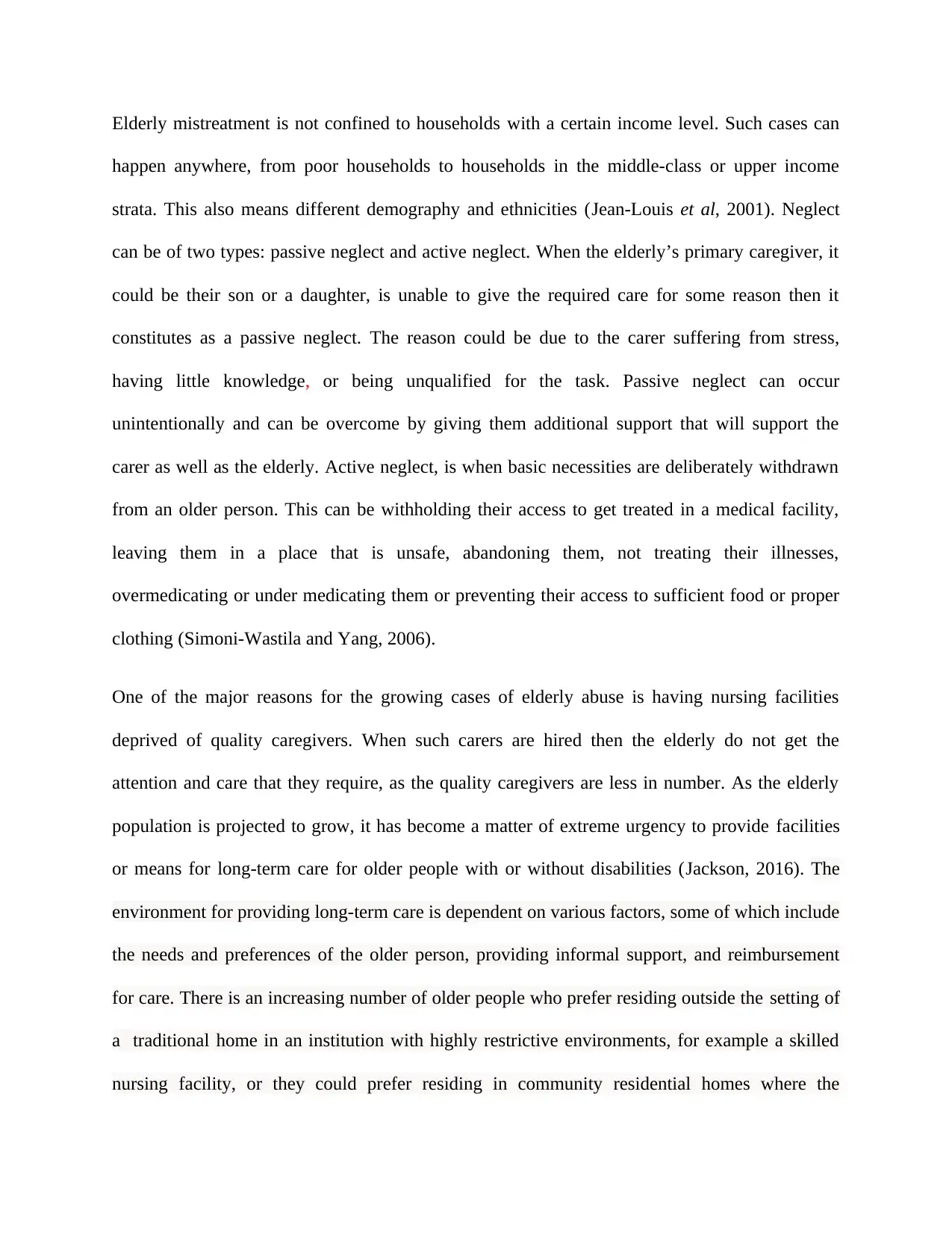
Elderly mistreatment is not confined to households with a certain income level. Such cases can
happen anywhere, from poor households to households in the middle-class or upper income
strata. This also means different demography and ethnicities (Jean-Louis et al, 2001). Neglect
can be of two types: passive neglect and active neglect. When the elderly’s primary caregiver, it
could be their son or a daughter, is unable to give the required care for some reason then it
constitutes as a passive neglect. The reason could be due to the carer suffering from stress,
having little knowledge, or being unqualified for the task. Passive neglect can occur
unintentionally and can be overcome by giving them additional support that will support the
carer as well as the elderly. Active neglect, is when basic necessities are deliberately withdrawn
from an older person. This can be withholding their access to get treated in a medical facility,
leaving them in a place that is unsafe, abandoning them, not treating their illnesses,
overmedicating or under medicating them or preventing their access to sufficient food or proper
clothing (Simoni-Wastila and Yang, 2006).
One of the major reasons for the growing cases of elderly abuse is having nursing facilities
deprived of quality caregivers. When such carers are hired then the elderly do not get the
attention and care that they require, as the quality caregivers are less in number. As the elderly
population is projected to grow, it has become a matter of extreme urgency to provide facilities
or means for long-term care for older people with or without disabilities (Jackson, 2016). The
environment for providing long-term care is dependent on various factors, some of which include
the needs and preferences of the older person, providing informal support, and reimbursement
for care. There is an increasing number of older people who prefer residing outside the setting of
a traditional home in an institution with highly restrictive environments, for example a skilled
nursing facility, or they could prefer residing in community residential homes where the
happen anywhere, from poor households to households in the middle-class or upper income
strata. This also means different demography and ethnicities (Jean-Louis et al, 2001). Neglect
can be of two types: passive neglect and active neglect. When the elderly’s primary caregiver, it
could be their son or a daughter, is unable to give the required care for some reason then it
constitutes as a passive neglect. The reason could be due to the carer suffering from stress,
having little knowledge, or being unqualified for the task. Passive neglect can occur
unintentionally and can be overcome by giving them additional support that will support the
carer as well as the elderly. Active neglect, is when basic necessities are deliberately withdrawn
from an older person. This can be withholding their access to get treated in a medical facility,
leaving them in a place that is unsafe, abandoning them, not treating their illnesses,
overmedicating or under medicating them or preventing their access to sufficient food or proper
clothing (Simoni-Wastila and Yang, 2006).
One of the major reasons for the growing cases of elderly abuse is having nursing facilities
deprived of quality caregivers. When such carers are hired then the elderly do not get the
attention and care that they require, as the quality caregivers are less in number. As the elderly
population is projected to grow, it has become a matter of extreme urgency to provide facilities
or means for long-term care for older people with or without disabilities (Jackson, 2016). The
environment for providing long-term care is dependent on various factors, some of which include
the needs and preferences of the older person, providing informal support, and reimbursement
for care. There is an increasing number of older people who prefer residing outside the setting of
a traditional home in an institution with highly restrictive environments, for example a skilled
nursing facility, or they could prefer residing in community residential homes where the
Paraphrase This Document
Need a fresh take? Get an instant paraphrase of this document with our AI Paraphraser
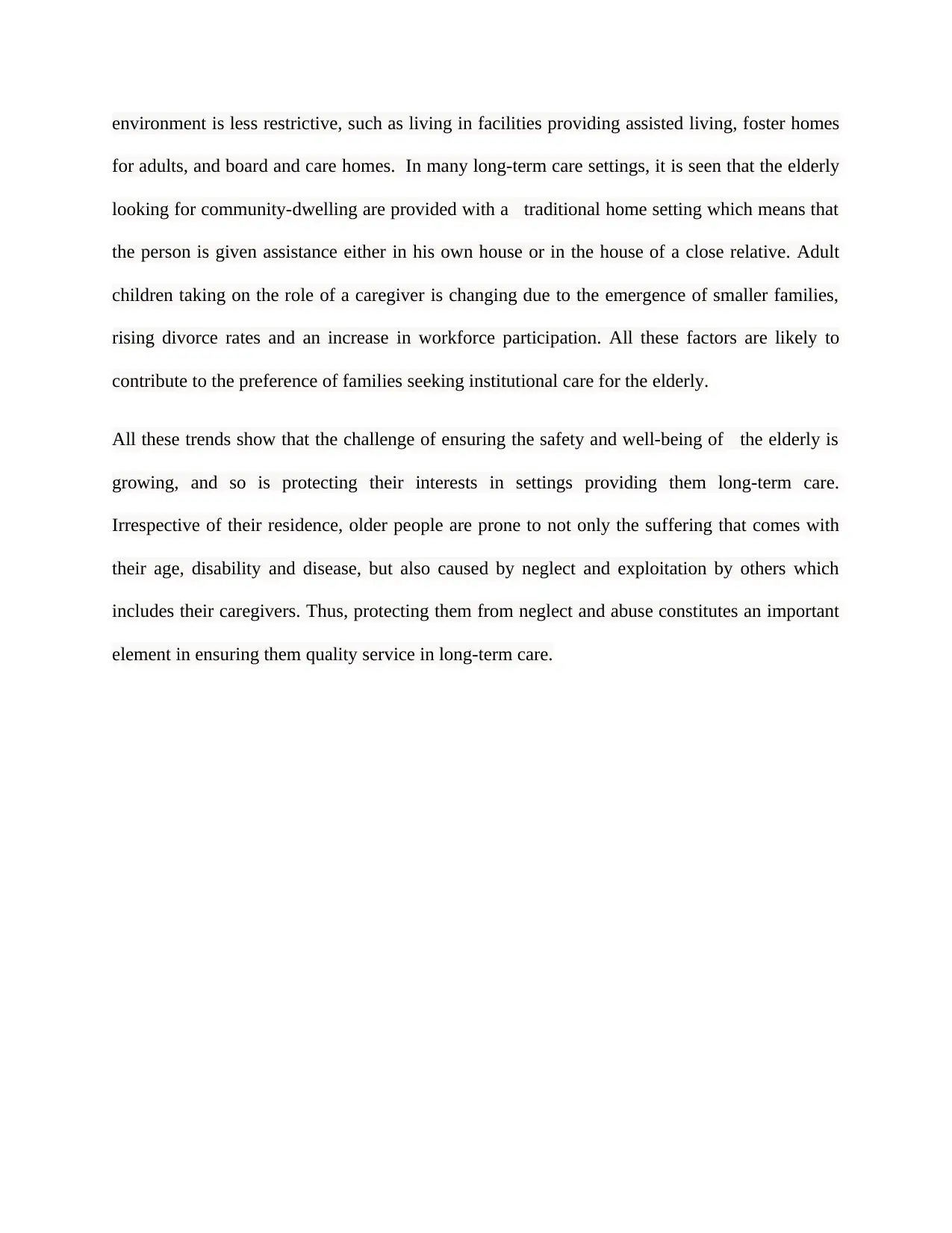
environment is less restrictive, such as living in facilities providing assisted living, foster homes
for adults, and board and care homes. In many long-term care settings, it is seen that the elderly
looking for community-dwelling are provided with a traditional home setting which means that
the person is given assistance either in his own house or in the house of a close relative. Adult
children taking on the role of a caregiver is changing due to the emergence of smaller families,
rising divorce rates and an increase in workforce participation. All these factors are likely to
contribute to the preference of families seeking institutional care for the elderly.
All these trends show that the challenge of ensuring the safety and well-being of the elderly is
growing, and so is protecting their interests in settings providing them long-term care.
Irrespective of their residence, older people are prone to not only the suffering that comes with
their age, disability and disease, but also caused by neglect and exploitation by others which
includes their caregivers. Thus, protecting them from neglect and abuse constitutes an important
element in ensuring them quality service in long-term care.
for adults, and board and care homes. In many long-term care settings, it is seen that the elderly
looking for community-dwelling are provided with a traditional home setting which means that
the person is given assistance either in his own house or in the house of a close relative. Adult
children taking on the role of a caregiver is changing due to the emergence of smaller families,
rising divorce rates and an increase in workforce participation. All these factors are likely to
contribute to the preference of families seeking institutional care for the elderly.
All these trends show that the challenge of ensuring the safety and well-being of the elderly is
growing, and so is protecting their interests in settings providing them long-term care.
Irrespective of their residence, older people are prone to not only the suffering that comes with
their age, disability and disease, but also caused by neglect and exploitation by others which
includes their caregivers. Thus, protecting them from neglect and abuse constitutes an important
element in ensuring them quality service in long-term care.
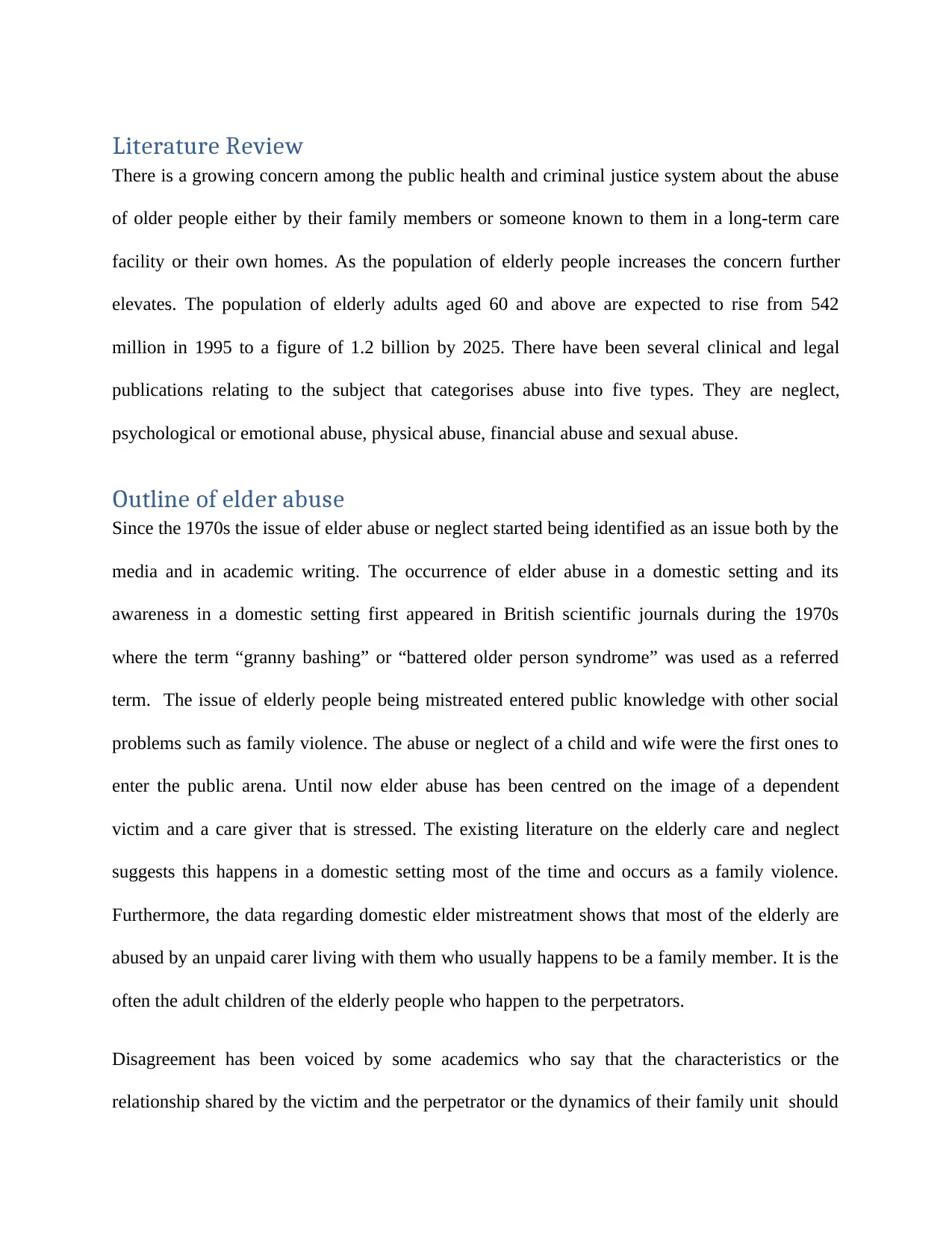
Literature Review
There is a growing concern among the public health and criminal justice system about the abuse
of older people either by their family members or someone known to them in a long-term care
facility or their own homes. As the population of elderly people increases the concern further
elevates. The population of elderly adults aged 60 and above are expected to rise from 542
million in 1995 to a figure of 1.2 billion by 2025. There have been several clinical and legal
publications relating to the subject that categorises abuse into five types. They are neglect,
psychological or emotional abuse, physical abuse, financial abuse and sexual abuse.
Outline of elder abuse
Since the 1970s the issue of elder abuse or neglect started being identified as an issue both by the
media and in academic writing. The occurrence of elder abuse in a domestic setting and its
awareness in a domestic setting first appeared in British scientific journals during the 1970s
where the term “granny bashing” or “battered older person syndrome” was used as a referred
term. The issue of elderly people being mistreated entered public knowledge with other social
problems such as family violence. The abuse or neglect of a child and wife were the first ones to
enter the public arena. Until now elder abuse has been centred on the image of a dependent
victim and a care giver that is stressed. The existing literature on the elderly care and neglect
suggests this happens in a domestic setting most of the time and occurs as a family violence.
Furthermore, the data regarding domestic elder mistreatment shows that most of the elderly are
abused by an unpaid carer living with them who usually happens to be a family member. It is the
often the adult children of the elderly people who happen to the perpetrators.
Disagreement has been voiced by some academics who say that the characteristics or the
relationship shared by the victim and the perpetrator or the dynamics of their family unit should
There is a growing concern among the public health and criminal justice system about the abuse
of older people either by their family members or someone known to them in a long-term care
facility or their own homes. As the population of elderly people increases the concern further
elevates. The population of elderly adults aged 60 and above are expected to rise from 542
million in 1995 to a figure of 1.2 billion by 2025. There have been several clinical and legal
publications relating to the subject that categorises abuse into five types. They are neglect,
psychological or emotional abuse, physical abuse, financial abuse and sexual abuse.
Outline of elder abuse
Since the 1970s the issue of elder abuse or neglect started being identified as an issue both by the
media and in academic writing. The occurrence of elder abuse in a domestic setting and its
awareness in a domestic setting first appeared in British scientific journals during the 1970s
where the term “granny bashing” or “battered older person syndrome” was used as a referred
term. The issue of elderly people being mistreated entered public knowledge with other social
problems such as family violence. The abuse or neglect of a child and wife were the first ones to
enter the public arena. Until now elder abuse has been centred on the image of a dependent
victim and a care giver that is stressed. The existing literature on the elderly care and neglect
suggests this happens in a domestic setting most of the time and occurs as a family violence.
Furthermore, the data regarding domestic elder mistreatment shows that most of the elderly are
abused by an unpaid carer living with them who usually happens to be a family member. It is the
often the adult children of the elderly people who happen to the perpetrators.
Disagreement has been voiced by some academics who say that the characteristics or the
relationship shared by the victim and the perpetrator or the dynamics of their family unit should
⊘ This is a preview!⊘
Do you want full access?
Subscribe today to unlock all pages.

Trusted by 1+ million students worldwide
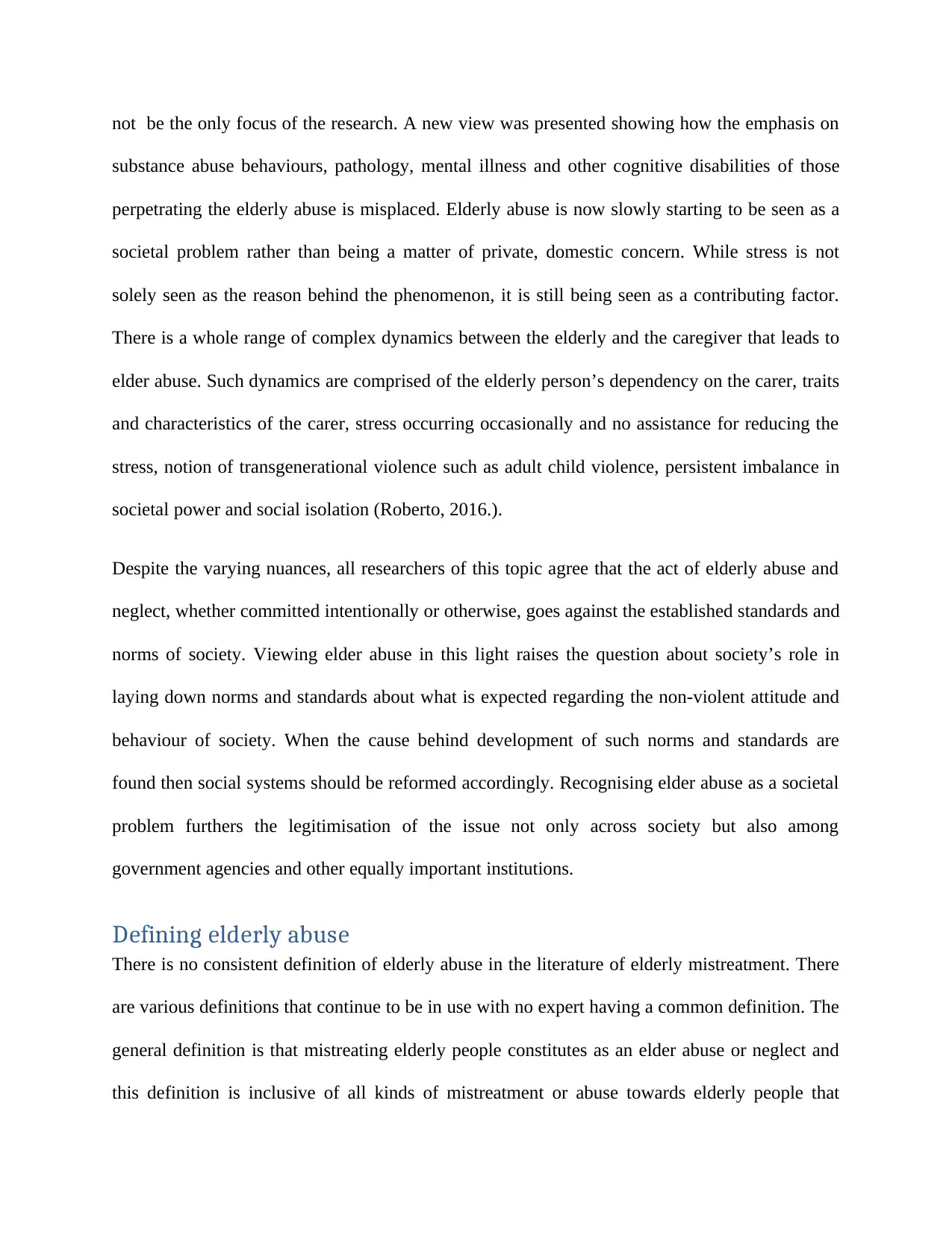
not be the only focus of the research. A new view was presented showing how the emphasis on
substance abuse behaviours, pathology, mental illness and other cognitive disabilities of those
perpetrating the elderly abuse is misplaced. Elderly abuse is now slowly starting to be seen as a
societal problem rather than being a matter of private, domestic concern. While stress is not
solely seen as the reason behind the phenomenon, it is still being seen as a contributing factor.
There is a whole range of complex dynamics between the elderly and the caregiver that leads to
elder abuse. Such dynamics are comprised of the elderly person’s dependency on the carer, traits
and characteristics of the carer, stress occurring occasionally and no assistance for reducing the
stress, notion of transgenerational violence such as adult child violence, persistent imbalance in
societal power and social isolation (Roberto, 2016.).
Despite the varying nuances, all researchers of this topic agree that the act of elderly abuse and
neglect, whether committed intentionally or otherwise, goes against the established standards and
norms of society. Viewing elder abuse in this light raises the question about society’s role in
laying down norms and standards about what is expected regarding the non-violent attitude and
behaviour of society. When the cause behind development of such norms and standards are
found then social systems should be reformed accordingly. Recognising elder abuse as a societal
problem furthers the legitimisation of the issue not only across society but also among
government agencies and other equally important institutions.
Defining elderly abuse
There is no consistent definition of elderly abuse in the literature of elderly mistreatment. There
are various definitions that continue to be in use with no expert having a common definition. The
general definition is that mistreating elderly people constitutes as an elder abuse or neglect and
this definition is inclusive of all kinds of mistreatment or abuse towards elderly people that
substance abuse behaviours, pathology, mental illness and other cognitive disabilities of those
perpetrating the elderly abuse is misplaced. Elderly abuse is now slowly starting to be seen as a
societal problem rather than being a matter of private, domestic concern. While stress is not
solely seen as the reason behind the phenomenon, it is still being seen as a contributing factor.
There is a whole range of complex dynamics between the elderly and the caregiver that leads to
elder abuse. Such dynamics are comprised of the elderly person’s dependency on the carer, traits
and characteristics of the carer, stress occurring occasionally and no assistance for reducing the
stress, notion of transgenerational violence such as adult child violence, persistent imbalance in
societal power and social isolation (Roberto, 2016.).
Despite the varying nuances, all researchers of this topic agree that the act of elderly abuse and
neglect, whether committed intentionally or otherwise, goes against the established standards and
norms of society. Viewing elder abuse in this light raises the question about society’s role in
laying down norms and standards about what is expected regarding the non-violent attitude and
behaviour of society. When the cause behind development of such norms and standards are
found then social systems should be reformed accordingly. Recognising elder abuse as a societal
problem furthers the legitimisation of the issue not only across society but also among
government agencies and other equally important institutions.
Defining elderly abuse
There is no consistent definition of elderly abuse in the literature of elderly mistreatment. There
are various definitions that continue to be in use with no expert having a common definition. The
general definition is that mistreating elderly people constitutes as an elder abuse or neglect and
this definition is inclusive of all kinds of mistreatment or abuse towards elderly people that
Paraphrase This Document
Need a fresh take? Get an instant paraphrase of this document with our AI Paraphraser
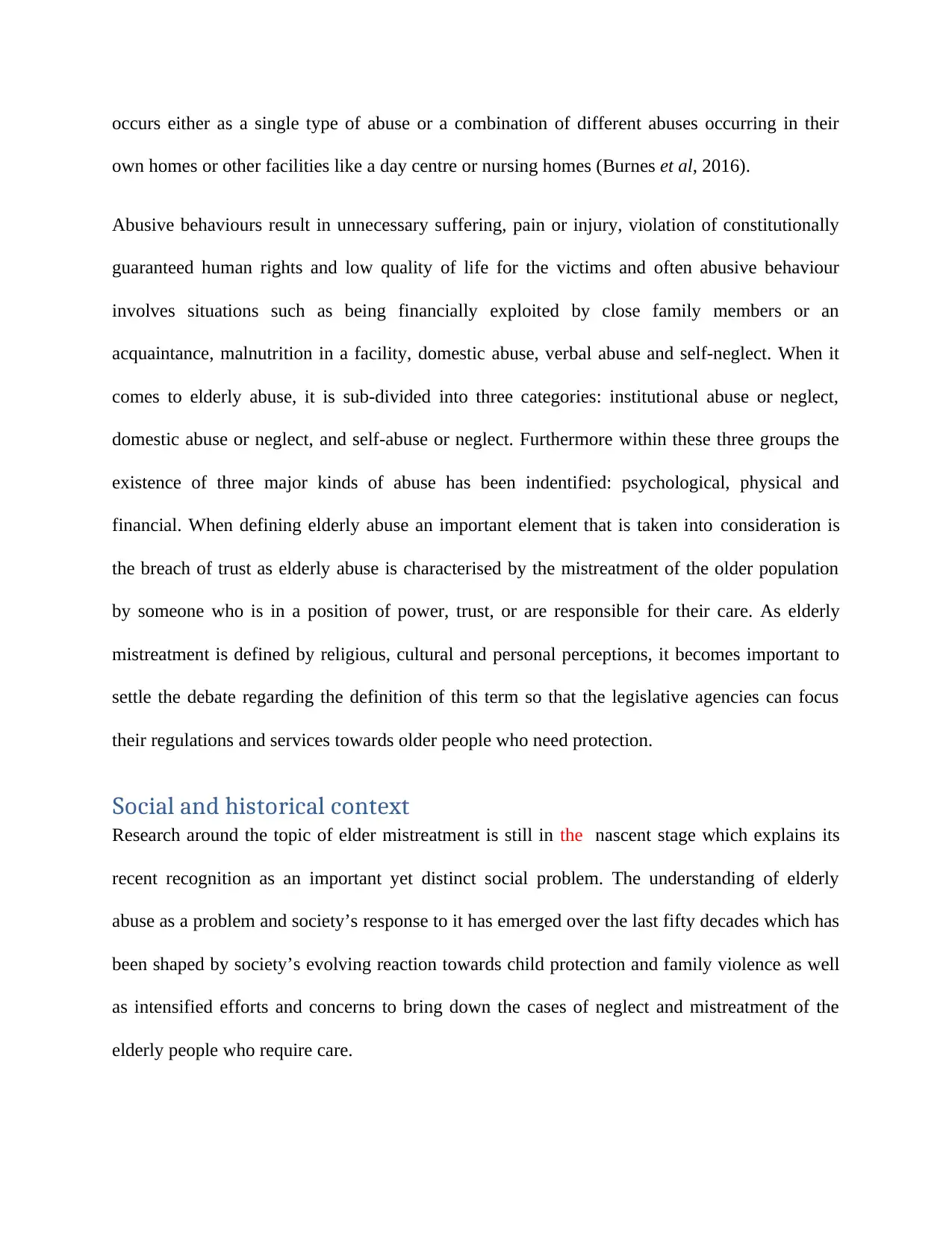
occurs either as a single type of abuse or a combination of different abuses occurring in their
own homes or other facilities like a day centre or nursing homes (Burnes et al, 2016).
Abusive behaviours result in unnecessary suffering, pain or injury, violation of constitutionally
guaranteed human rights and low quality of life for the victims and often abusive behaviour
involves situations such as being financially exploited by close family members or an
acquaintance, malnutrition in a facility, domestic abuse, verbal abuse and self-neglect. When it
comes to elderly abuse, it is sub-divided into three categories: institutional abuse or neglect,
domestic abuse or neglect, and self-abuse or neglect. Furthermore within these three groups the
existence of three major kinds of abuse has been indentified: psychological, physical and
financial. When defining elderly abuse an important element that is taken into consideration is
the breach of trust as elderly abuse is characterised by the mistreatment of the older population
by someone who is in a position of power, trust, or are responsible for their care. As elderly
mistreatment is defined by religious, cultural and personal perceptions, it becomes important to
settle the debate regarding the definition of this term so that the legislative agencies can focus
their regulations and services towards older people who need protection.
Social and historical context
Research around the topic of elder mistreatment is still in the nascent stage which explains its
recent recognition as an important yet distinct social problem. The understanding of elderly
abuse as a problem and society’s response to it has emerged over the last fifty decades which has
been shaped by society’s evolving reaction towards child protection and family violence as well
as intensified efforts and concerns to bring down the cases of neglect and mistreatment of the
elderly people who require care.
own homes or other facilities like a day centre or nursing homes (Burnes et al, 2016).
Abusive behaviours result in unnecessary suffering, pain or injury, violation of constitutionally
guaranteed human rights and low quality of life for the victims and often abusive behaviour
involves situations such as being financially exploited by close family members or an
acquaintance, malnutrition in a facility, domestic abuse, verbal abuse and self-neglect. When it
comes to elderly abuse, it is sub-divided into three categories: institutional abuse or neglect,
domestic abuse or neglect, and self-abuse or neglect. Furthermore within these three groups the
existence of three major kinds of abuse has been indentified: psychological, physical and
financial. When defining elderly abuse an important element that is taken into consideration is
the breach of trust as elderly abuse is characterised by the mistreatment of the older population
by someone who is in a position of power, trust, or are responsible for their care. As elderly
mistreatment is defined by religious, cultural and personal perceptions, it becomes important to
settle the debate regarding the definition of this term so that the legislative agencies can focus
their regulations and services towards older people who need protection.
Social and historical context
Research around the topic of elder mistreatment is still in the nascent stage which explains its
recent recognition as an important yet distinct social problem. The understanding of elderly
abuse as a problem and society’s response to it has emerged over the last fifty decades which has
been shaped by society’s evolving reaction towards child protection and family violence as well
as intensified efforts and concerns to bring down the cases of neglect and mistreatment of the
elderly people who require care.
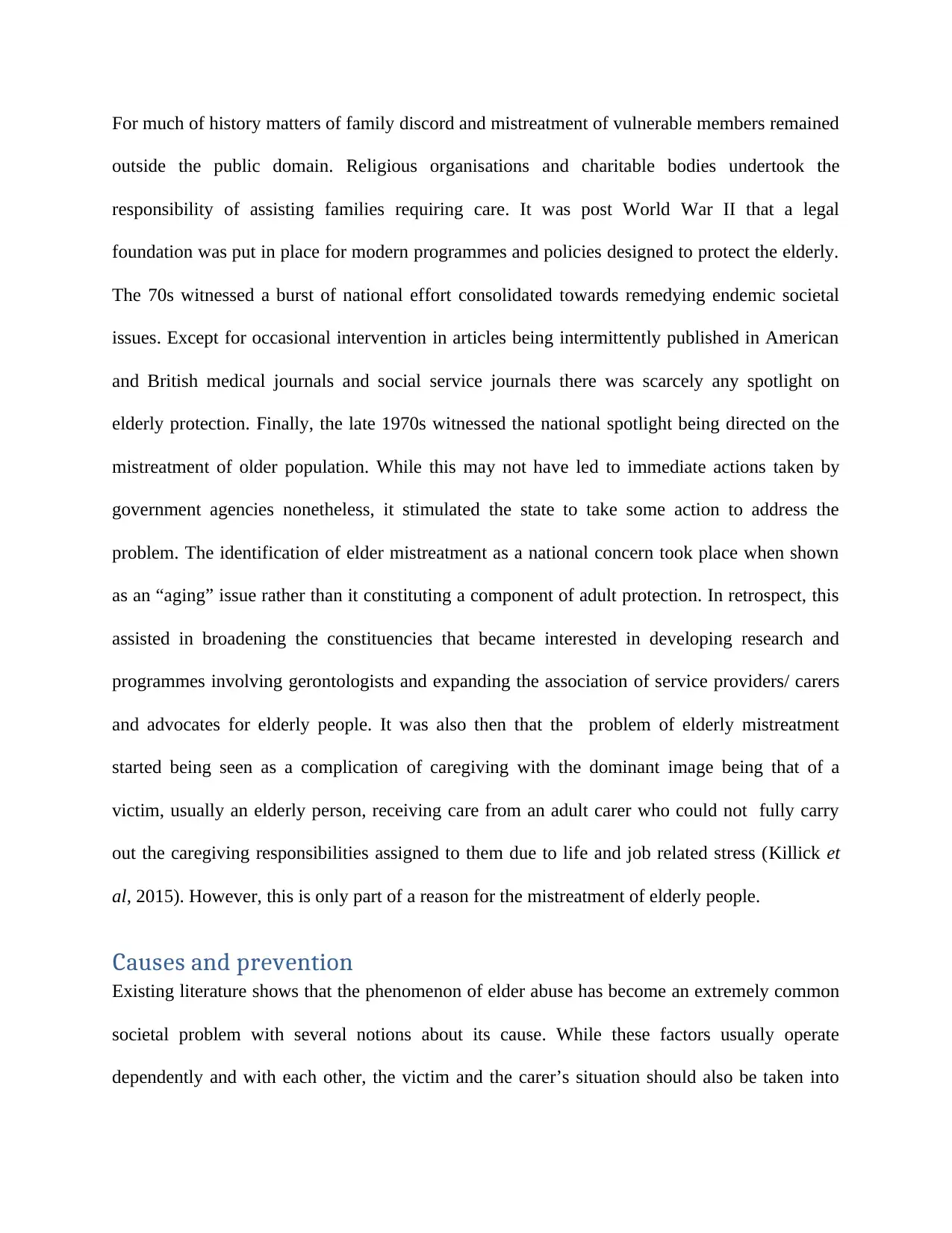
For much of history matters of family discord and mistreatment of vulnerable members remained
outside the public domain. Religious organisations and charitable bodies undertook the
responsibility of assisting families requiring care. It was post World War II that a legal
foundation was put in place for modern programmes and policies designed to protect the elderly.
The 70s witnessed a burst of national effort consolidated towards remedying endemic societal
issues. Except for occasional intervention in articles being intermittently published in American
and British medical journals and social service journals there was scarcely any spotlight on
elderly protection. Finally, the late 1970s witnessed the national spotlight being directed on the
mistreatment of older population. While this may not have led to immediate actions taken by
government agencies nonetheless, it stimulated the state to take some action to address the
problem. The identification of elder mistreatment as a national concern took place when shown
as an “aging” issue rather than it constituting a component of adult protection. In retrospect, this
assisted in broadening the constituencies that became interested in developing research and
programmes involving gerontologists and expanding the association of service providers/ carers
and advocates for elderly people. It was also then that the problem of elderly mistreatment
started being seen as a complication of caregiving with the dominant image being that of a
victim, usually an elderly person, receiving care from an adult carer who could not fully carry
out the caregiving responsibilities assigned to them due to life and job related stress (Killick et
al, 2015). However, this is only part of a reason for the mistreatment of elderly people.
Causes and prevention
Existing literature shows that the phenomenon of elder abuse has become an extremely common
societal problem with several notions about its cause. While these factors usually operate
dependently and with each other, the victim and the carer’s situation should also be taken into
outside the public domain. Religious organisations and charitable bodies undertook the
responsibility of assisting families requiring care. It was post World War II that a legal
foundation was put in place for modern programmes and policies designed to protect the elderly.
The 70s witnessed a burst of national effort consolidated towards remedying endemic societal
issues. Except for occasional intervention in articles being intermittently published in American
and British medical journals and social service journals there was scarcely any spotlight on
elderly protection. Finally, the late 1970s witnessed the national spotlight being directed on the
mistreatment of older population. While this may not have led to immediate actions taken by
government agencies nonetheless, it stimulated the state to take some action to address the
problem. The identification of elder mistreatment as a national concern took place when shown
as an “aging” issue rather than it constituting a component of adult protection. In retrospect, this
assisted in broadening the constituencies that became interested in developing research and
programmes involving gerontologists and expanding the association of service providers/ carers
and advocates for elderly people. It was also then that the problem of elderly mistreatment
started being seen as a complication of caregiving with the dominant image being that of a
victim, usually an elderly person, receiving care from an adult carer who could not fully carry
out the caregiving responsibilities assigned to them due to life and job related stress (Killick et
al, 2015). However, this is only part of a reason for the mistreatment of elderly people.
Causes and prevention
Existing literature shows that the phenomenon of elder abuse has become an extremely common
societal problem with several notions about its cause. While these factors usually operate
dependently and with each other, the victim and the carer’s situation should also be taken into
⊘ This is a preview!⊘
Do you want full access?
Subscribe today to unlock all pages.

Trusted by 1+ million students worldwide
1 out of 31
Related Documents
Your All-in-One AI-Powered Toolkit for Academic Success.
+13062052269
info@desklib.com
Available 24*7 on WhatsApp / Email
![[object Object]](/_next/static/media/star-bottom.7253800d.svg)
Unlock your academic potential
Copyright © 2020–2025 A2Z Services. All Rights Reserved. Developed and managed by ZUCOL.





